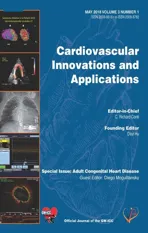The Adult Ventricular Septum; A Unique Portion of the Left and Right Ventricle
2018-03-21RichardContiMDMACCandJohnPetersenMDFACC
C.Richard Conti, MD, MACC and John W.Petersen, MD, FACC
Anatomic Considerations
The ventricular septum separates the right and left ventricles and thus is part of both ventricles.It is directed obliquely backward to the right, and curved with the convexity toward the right ventricle; it must be emphasized that the total cardiac septum has a complex, longitudinal twist and does not lie in any single plane.
Its upper and posterior part, is thin and fi brous,and is termed the membranous ventricular septum.The greater portion of the septum is thick and muscular and constitutes the muscular ventricular septum.
The ventricular septum consists of two layers, a thin layer on the RV side and a thicker layer on the LV side [1].The major septal arteries tend to run between these two layers.
lmaging the Ventricular Septum
Radiopaque contrast injection into the left ventricle in the LAO projection outlines the septum.Cardiac ultrasound, cardiac MR, and cardiac CT will illustrate anatomy as well as motion of the septum and possibly other features of the left and right side.
Blood Supply of the Ventricular Septum
In the normal heart, the major blood supply of the ventricular septum was defined by James and Burch
[2] using post-mortem evaluation, many years ago.Autopsy studies revealed the following
1.Major blood supply to the septum was derived from diagonally penetrating arteries entering from the left anterior descending coronary artery.
2.Branches from the posterior descending coronary artery supplied only a small zone of the ventricular septum near the region of the atrioventricular node.
3.The interventricular septum was noted to be an important site of collateral circulatory channels in the human heart.
Left Side vs.Right Side of the Ventricular Septum
Using echocardiography a bright line in the septum which separates the left from the right side of the septum was described by Fiegenbaum [3].This line appeared to divide the septum into a right sided and a left sided layer.The line was more pronounced in diastole than in systole.The line could be followed from the cardiac apex to the aortic root, disappearing at the left aortic cusp.
Two main hypotheses for the cause of the visualized acoustic interface are structural differences,such as an abrupt change in septal fi ber direction,and the presence of coronary arteries in the middle of the septum.The origin of the bright line separating the septum into a left and a right side is still not known.
Normal Septum
The ventricular septum functions as part of the right and left ventricle.
The septum can be consistently divided into a left and a right side based on the bright echocardiographic signal.Also, the mechanical properties of the left and right of the ventricular septum are different in normal and abnormal hearts [1].Contraction of the myocardium in the radial direction (traditional wall thickening) is greater on the left side of the septum as compared to the right side of the septum.Contraction along the long axis of the ventricle (longitudinal strain) is not different between the left and right side of the septum in normal hearts.Radial contraction is likely different and longitudinal contraction not different between the two sides of the septum because of the myofiber orientation along the endocardium of the left and right ventricles.
Abnormal Septum
Two examples come to mind.
1.VSD;Unless there is pulmonary hypertension,the shunt is always left to right and usually involves the membranous septum.An exception is Tetralogy of Fallot in which there is RV infundibular stenosis (or pulmonary stenosis) and membranous septal defect, resulting in a right to left shunt.Muscular septum VSD’s occur congenitally but more commonly occur after septal myocardial infarction.
2.Hypertrophic cardiomyopathy;The prominent Asymmetric Septal Hypertrophy of HCM is usually on the left side but occasionally can also be seen on the right side of the septum.
RV Septal Pacing
Pacing the RV septum creates LBBB on the ECG and left ventricular dyssynchrony which may result in decreased cardiac output.Bi-ventricular pacing, i.e.RV septal and L.ventricular free wall pacing, may decrease dyssynchrony and improve synchronous contraction of the left ventricle and increase cardiac output.Strain imaging may document mechanical consequences of RV pacing but also help predict which patient with underlying RV conduction and contraction abnormalities that are likely to decompensate with RV pacing.
Conduction
The normal electrical conduction in the heart stimulates the right and left ventricular cardiac muscle.Two bundle branches spread out to produce Purkinje fi bers, which stimulate individual groups of myocardial cells to contract synchronously.
What Happens to Septal Blood Flow When RV Pressure is the Same as LV Pressure in Systole and Diastole?
At the present time there are no results found for what happens to septal blood fl ow when RV pressure is the same as LV pressure.As far as I can tell,this has not been studied with CMR or other perfusion studies.
Future Directions
The ventricular septum is a unique structure that contributes to the performance of both the right and left ventricles.Advanced imaging techniques, such as speckle tracking echo or cardiac MRI derived strain imaging, allow us to quantify the mechanical patterns of ventricular contraction in patients with various disease.We feel it will be important for future studies to:
• Measure longitudinal, radial, and circumferential strain in the layers of the ventricular septum(left side and right side) to determine if right side contractile defects correlate with left side contractile defects in various pathologies.
• Determine if deficits in contraction of the ventricular septum provide stronger prediction of adverse CV events as compared to deficits in the other walls of the RV and LV, e.g.lateral walls.
REFERENCES
1.Boettler P, Claus P, Herbots L,McLaughlin M, D’hooge J, Bijnens B, et al.New aspects of the ventricular septum and its function:an echocardiographic study.Heart 2005;91:1343–8.
2.James TN, Burch GE.Blood supply of the human interventricular septum.Circulation 1958;17:391.
3.Feigenbaum H.Echocardiography.3rd ed.Philadelphia: Lea and Febiger; 1981.p.454.
